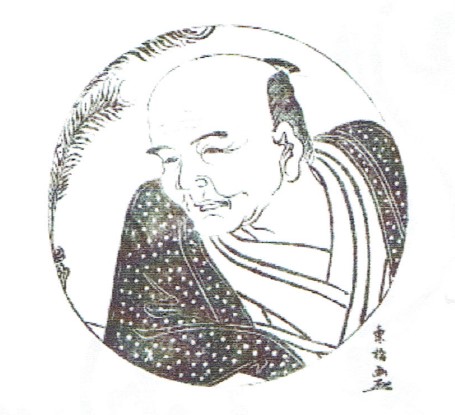「英語でセンリュウ!」
(Let’s Enjoy Senryu in English!)
解説:18世川柳 平 川柳(東京川柳会主宰)
翻訳:Andrew Houwen(東京女子大学准教授)
Ⅰ「川柳」(センリュウ)って何ですか、俳句との違いは?
川柳は18世紀中頃、江戸に誕生した短詩文芸です。俳句と異なり、季語や切れ字などの制約がなく、話し言葉(口語)を用い、主に社会生活の中で生きる人間の<喜怒哀楽>を「穿(うが)ち」と呼ばれる「アイロニー(irony)」の視点で詠みます。

Ⅰ What are senryu, and how are they different from haiku?
Senryu are a kind of short poem that arose in Edo in the mid-eighteenth century. They are different from haiku because they do not employ season words or cutting words. They use colloquial language and often approach people’s emotions in society from an ironic perspective called ugachi (‘cutting through’, ‘drilling’, or ‘scrutiny’).
Ⅱ 川柳を創始した柄井川柳と江戸の伝統川柳
これは、『誹風 柳多留』に掲載された柄井川柳(1718-90)の画像です。
1757年、新しい庶民の短詩文芸を創造した柄井川柳の雅号「川柳」は、のちに文芸名となり、「川柳」という名称で呼ばれています。
1765年、柄井川柳が選句した作品集は『誹風 柳多留』と題され、刊行されました。そこに収められた作品は前句の題をとっても「一句にて句意のわかりやすき」ものになりました。この初篇には、次のような「伝統川柳」が収められています。
寝ていても団扇(うちわ)のうごく親心
この川柳は乳飲み子に添い寝する母親が家事に疲れて眠りに落ちてしまいますが、その間も母親は乳飲み子に対して団扇を動かしている姿が描かれています。そこに作者は、「親心」を強く感じたのです。
この伝統川柳には一行詩形の中に問いと答えが含まれています。例えば、「寝ていても団扇」が「動く」のは、どうしてかという問いを読者に投げかけます。その答えが「親心」になっているのです。こうした構造を「一章に問答」といいます。これは川柳が前句を離れて独立性を獲得するための条件として考えられたものです。そして「一章に問答」が完結することで、一句の内容が補完され、独立した「一行詩」として存在感をもつようになるのです。
この「一章に問答」の構造を用いることによって、川柳は俳句のように切れ字使用しなくとも、2つの要素―問いと答え―がその一行詩形の中で融合し、新しい関係性を作り出すことを可能にしたのです。
ⅡKarai Senryu, who created the senryu, and traditional senryu in Edo
This is a picture of Karai Senryu (1718-90) in Haifu yanagitaru (‘The Willow Barrel of Poetic and Ironic Verses’). In 1757, Karai Senryu, who created this new popular genre of literature, began using the gago (雅号) ‘Senryu’ (‘River Willow’), and is still referred to by this name.
In 1765, the collection of verses Senryu selected for his reading were published under the title Haifu yanagitaru. Even when they were maeku (‘previous verse’), they were supposed to be ‘easy to understand as a standalone verse’. In this first edition, the following ‘traditional senryu’ is included in it:
寝ていても団扇(うちわ)のうごく親心
nete ite mo uchiwa no ugoku oyagokoro
even as she sleeps, it keeps moving the fan ― a parent’s heart
This senryu describes how a mother sleeping next to the child she is nursing, exhausted from her chores, falls asleep but the fan keeps moving. In this verse, the writer strongly felt the ‘parent’s heart’.
Within the one-line form of this traditional senryu, there is a question and response. For example, what ‘keeps moving the fan’, ‘even when asleep’, is the question given to the reader. The answer is ‘a parent’s heart’. This kind of structure is called issho ni mondo (‘a question and an answer in one verse’). It is thought that this separates the senryu from the maeku and allows it to stand as an independent, one-line poem.
By using this issho ni mondo structure, even without the ‘cutting word’ of a haiku, two elements ― a question and an answer ― can be brought together to form a relationship between them.
Ⅲ 柄井川柳没後の川柳宗家の系譜
柄井川柳の死後、その川柳の雅号は柄井川柳の血縁者が三世代継承しますが、1824年、2世川柳の弟子の人見周助(1778‐1844)が4世川柳を嗣号します。4世川柳は「俳風狂句元祖」と名乗り、文芸名を「狂句」と改めました。こうして4世川柳は当時、多くの信者を傘下におさめ、「狂句」という名称を広めました。
6世川柳 水谷川柳(1814‐82)は明治時代(1868‐1912)を迎えて最初の川柳宗家です。彼は川柳宗家の主宰する「柳風会」を組織し、創始します。
1948年、東京川柳会は14世川柳 根岸川柳(1888-1977)によって創始されました。この川柳結社は江戸時代から代々川柳宗家が主宰してきました。14世川柳は戦後はじめての川柳宗家でした。
根岸川柳没後、川柳の嗣号は15世川柳 脇屋川柳(1962-2017)、16世川柳 青田川柳(1928-2018)、17世川柳 石川川柳(1938-現・柳翁)、18世川柳 平 川柳(1958-)によって継承されました。
Ⅲ The succession of the Senryu name after Karai Senryu’s death
After Karai Senryu’s death, the literary name was inherited for the first three generations by his blood descendants, but in 1824 one of the second Senryu’s disciples, Hitomi Shusuke (1778-1844), became the fourth Senryu. In his Haifu kyoku ganso (‘The Inventors of Rhetorical and Comic Mad Verses’), the fourth Senryu renamed the senryu verses kyoku (mad verses) and popularized the writing of kyoku through his many adherents.
The sixth Senryu, Mizutani Senryu (1814-82), was the first to live into the Meiji Era (1868-1912). He founded the Ryufu kai (Willow Wind Assciation ) that the head of the Senryu family presides over.
In 1948, the Tokyo Senryu Association was founded by the fourteenth Senryu, Negishi Senryu (1888-1977), which has been led by the head of the Senryu family since the Edo period. He was the first the head of the Senryu family after the war.
After Negishi Senryu’s death, the Senryu name was inherited by the fifteenth Senryu, Wakiya Senryu (1962-2017), the sixteenth Senryu, Aota Senryu (1928-2018), the seventeenth Senryu, Ishikawa Senryu (1938-), and the eighteenth Senryu, Taira Senryu (1958-).
Ⅳ 井上剣花坊と阪井久良岐の近代川柳の時代
近代川柳の時代は井上剣花坊(1870-1934)と阪井久良岐(1869-1945)によって推進されました。
川柳の改革は正岡子規の発句や和歌の改良の後に行われました。正岡子規(1867-1902)は俳句との比較において川柳について言及していますが、この時代には、まだ「川柳」という名称よりは「狂句」という名称が一般的でした。「川柳」という名称が一般に定着していくのは、1903(明治36)年前後からです。
1902(明治35)年には、『文芸界』という雑誌に中根香亭(1839-1913)の「前句源流」という論文が連載され、「川柳」という文芸の歴史がはじめて公(おおやけ)になりました。
同じ年に阪井久良岐は『川柳梗概』を刊行し、川柳宗家による狂句の否定と初世川柳の選句した「古川柳」への回帰を唱え、「狂句百年の負債を返せ」というスローガンを掲げ、川柳の改革を訴えました。
井上剣花坊は正岡子規の俳句や短歌の革新運動を意識し、1903(明治36)年7月3日、「新題柳樽」欄を設けました。2年後、彼は柳樽寺川柳会を創設し、機関誌『川柳』を発刊し、「新川柳」の創造に意欲を燃やしました。
Ⅳ The period of the ‘modern senryu’ of Inoue Kenkabo and Sakai Kuraki
The period of ‘modern senryu’ was instigated by Inoue Kenkabo (1870-1934) and Sakai Kuraki (1869-1902). The senryu reforms occurred after Masaoka Shiki’s reforms of hokku and waka in the 1890s.
Although the term ‘senryu’ for what was until then more generally known as a kyoku was used by Shiki in comparison with haiku, its widespread adoption as the term for this poetic form arose in around 1903.
In 1902, an article on ‘The Origins of Maeku’ by Nakane Kotei in the magazine Bungeikai (‘The Art World’) gave the first published historical overview of senryu until then and became an important theoretical foundation for new senryu.
In the same year, Sakai Kuraki brought out Senryu kogai (‘An Outline of Senryu’), which criticized the kyoku of the then current Senryu and advocated a return to the ‘old senryu’ of the eighteenth century. It demanded the reform of the genre with the slogan ‘return the debt of a century of kyoku’.
Kenkabo was aware of Shiki’s haiku and tanka reform movement and on 3 July 1903 began writing a column in the newspaper Nippon entitled ‘The New Willow Barrel’. Two years later, he set up the Ryusonji Senryu Society and founded the magazine Senryu, thus creating much enthusiasm for ‘new senryu’.
Ⅴ 大正時代の井上剣花坊とアメリカの詩人ウオルト ホイットマン
大正時代(1912-1926)の1919(大正8)年8月、井上剣花坊は『川柳を作る人に』(南北社)と題する著書を刊行しました。この著書ではクローバルな視座から川柳について論じています。彼は「新川柳」を「世界に類を見ない民衆芸術」と捉え、川柳を「一呼吸詩」と呼ぼうと提唱します。さらに彼は「新川柳は詩でなければならない。」、それは「対象物の中へわが心を打ち込んで、その生命と共に生きるものでなければならない。」、「文壇の民衆詩でなければならない。」、「自由詩でなければならない。」と力説します。剣花坊のこうした川柳観の形成にはアメリカの民衆詩人ウオルト ホイットマン(1819-92)による影響が強く認められます。
V Inoue Kenkabo in the Taisho period and the American poet Walt Whitman
In August 1919, Kenkabo published Senryu o tsukuru hito ni (‘For the Senryu Writer’), which discussed senryu in a global literary context. He saw ‘new senryu’ as a ‘popular art form for the whole world’ and advocated calling the senryu ‘one-breath poetry’. Furthermore, he emphasized that it ‘has to be shi’ (the term used at that time for Western poetry and as a broader category encompassing Western poetry, haiku, tanka, and other forms that had not been considered as a single literary genre until only a few decades before Kenkabo’s book), that it ‘has to live like the life that strikes our hearts’, that it has to be ‘a poetry of ordinary people’, and that ‘it has to be free verse’.
Kenkabo’s view of senryu was strongly influenced by the American popular poet Walt Whitman (1819-92), whose work was fashionable in the Japanese poetry world at that time. The year Kenkabo published Senryu o tsukuru hito ni was also the centenary of Whitman’s birth, when Whitman’s poetry was at the height of a boom in Japan.
